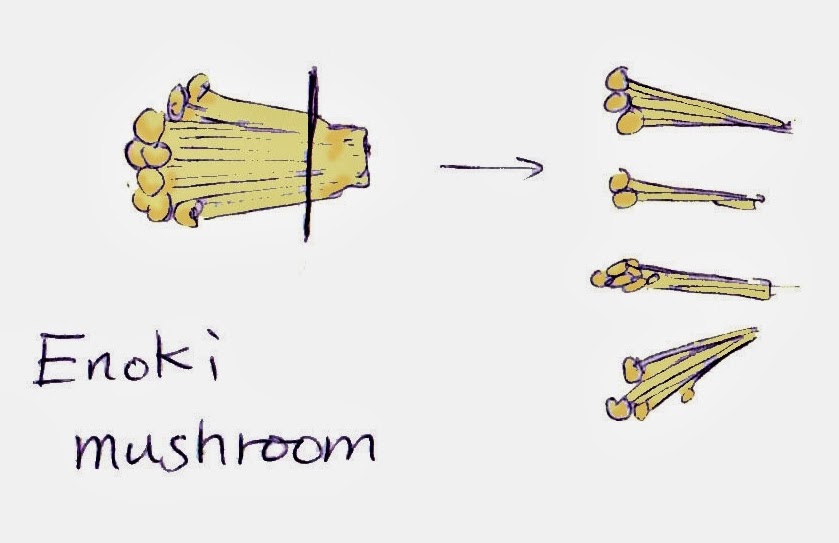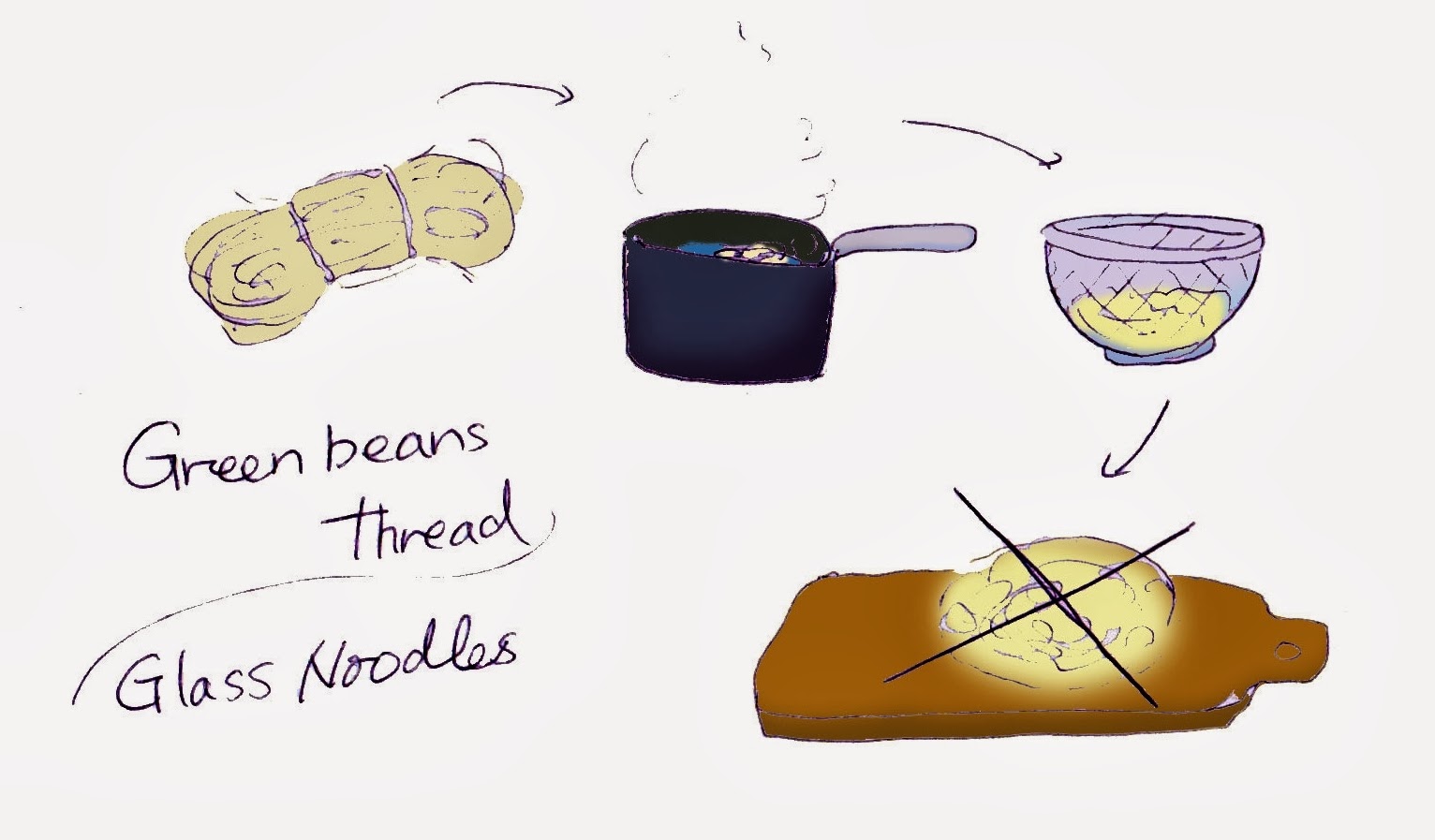Today 2 dish in one go: Yun bai rou and Patan. Both of them are kind of junk food, awfully indulge you but I cannot label it with "healthy food" ever.
 Patan is like an oriental peperoncino, served as a Tsuke men (dipping ramen). This was a dish introduced in a Japanese drama call "Kodoku no Gurume (lonely gourmet)". The story's about a mid-age business man; one every story, he goes to different restaurant on his lunch break, alone. A very unique drama, the story is just about the food: all through the show, he comments about how the taste of his meals quietly in his mind, along with the long shot of each food and how he eats.
My family sent that to me but the drama is a killer; just indulge my appetite but I'm not in Japan, I can't go to the restaurant to try... I just had to make it up.
Patan is like an oriental peperoncino, served as a Tsuke men (dipping ramen). This was a dish introduced in a Japanese drama call "Kodoku no Gurume (lonely gourmet)". The story's about a mid-age business man; one every story, he goes to different restaurant on his lunch break, alone. A very unique drama, the story is just about the food: all through the show, he comments about how the taste of his meals quietly in his mind, along with the long shot of each food and how he eats.
My family sent that to me but the drama is a killer; just indulge my appetite but I'm not in Japan, I can't go to the restaurant to try... I just had to make it up.
So this Patan recipe is totally my own creation based on my imagination from the drama, became one of the most demanded meal at my home lately.
 To make the Patan, I need some pork soup, that also comes with this very nice boiled pork belly dish call Yun bai rou. Originally a typical Sichuan cousin, which imported and became popular in Japan.
To make the Patan, I need some pork soup, that also comes with this very nice boiled pork belly dish call Yun bai rou. Originally a typical Sichuan cousin, which imported and became popular in Japan.
Yun bai rou means "meat that white as a cloud"; it should be sliced thin as a thin cloud, but my family likes it a bit thicker than that. The sauce contains Tian Jiang you I introduced in the last post, it is really a great match to this dish.
Ingredients
for Yun bai rou (picture is a half of all I made, all gone by 3 people here):
 500g a Brock of Pork belly - chose the one flat, equally spread the white fat through the layers, not too thick.
500g a Brock of Pork belly - chose the one flat, equally spread the white fat through the layers, not too thick.
2 slice ginger (with skin but cleaned)
5cm leak (green part)
1 garlic crushed
1.8 litter water
Sauce & garnish:
1/2 cucumber (skin it, take off center seed and sliced thin)
2 Tbsp Tian Jiang You
2 Tbsp say sauce
1 Tbsp white vinegar
1 garlic grand or squeezed
 some chili oil if you like it even more spicy
some chili oil if you like it even more spicy
for Patan (for 3-4 people)
6 servings of medium egg noodles
(I use Instant one today, can be raw can be frozen, 2 serving per person for this recipe cause it's never enough for my family, you can have 1 or 2 up to you appetite)
5 garlic cloves crushed and chopped
1cm leak, white part - chopped (forgotten in the picture...)
 1 Tbsp soy sauce
1 Tbsp soy sauce
1 Tbsp sake
1 Tbsp sesame oil
1 Tbsp salt for soup
Method
Prepare Yun bai rou:
 1.Put the pork belly block, ginger a crushed garlic and the green part of leak (cut in halves) in a large pot, with about 1.8 litter of water, bring it to boil then turn down the heat to medium and keep simmering the pot.
1.Put the pork belly block, ginger a crushed garlic and the green part of leak (cut in halves) in a large pot, with about 1.8 litter of water, bring it to boil then turn down the heat to medium and keep simmering the pot.
2. Skim the scums and keep boiling the pork for about 1 hour, until the water reduce to 1/2. Take out the pork (don't drain the soup out!) and leave them aside.
3. Mix all sauce ingredients. The grand garlic makes the sauce spicy so check the taste before adding any chili oil if you prefer.
4. Cut cucumber in slices, pile it at the center of your dish.
5. Once the pork gets enough cool to handle, slice them - as thin as you can is the proper way, my family prefer it about 2 mm thick. I also trim the skin for my hubby and leave them for my son and I - we love the crunchy skins on.
6. Line up the slices of boiled pork belly around the cucumber, serve with the sauce.
*I usually finish this first then keep it in refrigerator until Patan is ready.
Prepare Patan
1. Prepare the soup first. Strain the soup from the pork belly above to a smaller pot, add 1 Tbsp salt then keep boiling to reduce it until 2/3. Leave it aside.
 Patan is like an oriental peperoncino, served as a Tsuke men (dipping ramen). This was a dish introduced in a Japanese drama call "Kodoku no Gurume (lonely gourmet)". The story's about a mid-age business man; one every story, he goes to different restaurant on his lunch break, alone. A very unique drama, the story is just about the food: all through the show, he comments about how the taste of his meals quietly in his mind, along with the long shot of each food and how he eats.
Patan is like an oriental peperoncino, served as a Tsuke men (dipping ramen). This was a dish introduced in a Japanese drama call "Kodoku no Gurume (lonely gourmet)". The story's about a mid-age business man; one every story, he goes to different restaurant on his lunch break, alone. A very unique drama, the story is just about the food: all through the show, he comments about how the taste of his meals quietly in his mind, along with the long shot of each food and how he eats.So this Patan recipe is totally my own creation based on my imagination from the drama, became one of the most demanded meal at my home lately.
 To make the Patan, I need some pork soup, that also comes with this very nice boiled pork belly dish call Yun bai rou. Originally a typical Sichuan cousin, which imported and became popular in Japan.
To make the Patan, I need some pork soup, that also comes with this very nice boiled pork belly dish call Yun bai rou. Originally a typical Sichuan cousin, which imported and became popular in Japan.Yun bai rou means "meat that white as a cloud"; it should be sliced thin as a thin cloud, but my family likes it a bit thicker than that. The sauce contains Tian Jiang you I introduced in the last post, it is really a great match to this dish.
Ingredients
for Yun bai rou (picture is a half of all I made, all gone by 3 people here):
 500g a Brock of Pork belly - chose the one flat, equally spread the white fat through the layers, not too thick.
500g a Brock of Pork belly - chose the one flat, equally spread the white fat through the layers, not too thick.2 slice ginger (with skin but cleaned)
5cm leak (green part)
1 garlic crushed
1.8 litter water
Sauce & garnish:
1/2 cucumber (skin it, take off center seed and sliced thin)
2 Tbsp Tian Jiang You
2 Tbsp say sauce
1 Tbsp white vinegar
1 garlic grand or squeezed
 some chili oil if you like it even more spicy
some chili oil if you like it even more spicyfor Patan (for 3-4 people)
6 servings of medium egg noodles
(I use Instant one today, can be raw can be frozen, 2 serving per person for this recipe cause it's never enough for my family, you can have 1 or 2 up to you appetite)
5 garlic cloves crushed and chopped
1cm leak, white part - chopped (forgotten in the picture...)
 1 Tbsp soy sauce
1 Tbsp soy sauce1 Tbsp sake
1 Tbsp sesame oil
1 Tbsp salt for soup
Method
Prepare Yun bai rou:
 1.Put the pork belly block, ginger a crushed garlic and the green part of leak (cut in halves) in a large pot, with about 1.8 litter of water, bring it to boil then turn down the heat to medium and keep simmering the pot.
1.Put the pork belly block, ginger a crushed garlic and the green part of leak (cut in halves) in a large pot, with about 1.8 litter of water, bring it to boil then turn down the heat to medium and keep simmering the pot.2. Skim the scums and keep boiling the pork for about 1 hour, until the water reduce to 1/2. Take out the pork (don't drain the soup out!) and leave them aside.
3. Mix all sauce ingredients. The grand garlic makes the sauce spicy so check the taste before adding any chili oil if you prefer.
4. Cut cucumber in slices, pile it at the center of your dish.
5. Once the pork gets enough cool to handle, slice them - as thin as you can is the proper way, my family prefer it about 2 mm thick. I also trim the skin for my hubby and leave them for my son and I - we love the crunchy skins on.
6. Line up the slices of boiled pork belly around the cucumber, serve with the sauce.
*I usually finish this first then keep it in refrigerator until Patan is ready.
Prepare Patan
1. Prepare the soup first. Strain the soup from the pork belly above to a smaller pot, add 1 Tbsp salt then keep boiling to reduce it until 2/3. Leave it aside.
2. Chop the crushed garlic and leak.
3. Boil enough water as your noodle's package states: the each package of medium egg noodles sold in UK are relatively small, we can have 2 servings per person easily. It's totally up to you how much you boil.
4. Boil a large pot of hot water, put those instant noodles and boil for - the length the package states.
5. Drain the noodles to a strainer, now splash the sake and soy sauce on the noodle in the strainer. Mix them easily using a folk or chopsticks.
6. Now the finishing part: you'll do 2 things in once: heat up the soup again while frying the noodles.
In a wok or a large frying pan which can fit all noodles, put all sesame oil, chopped garlic and leak, heat up the oil on pan for just until garlic start to smell then stop the heat.
7. Place all noodles in the pan, just mix with the garlic and oil. If your noodles are dry and difficult to handle, add extra sesame oil about 1 Tbsp.
8. Serve the soup in a small cup, each portion of noodles in a large bowl.
How to eat:
You can eat the noodles as it is, you can dip it into the soup, you can put the soup on the noodles, that's up to you. I love the combination of the noodles dipped in the hot soup and cold pork belly going together.

































